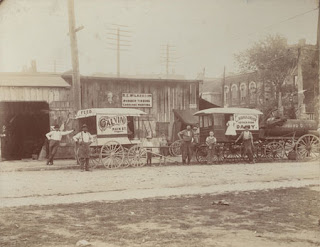 |
| Photo, Kentucky Museum |
The Kentucky Standard
Bowling Green Kentucky, Saturday morning
One Cent Reward The undersigned takes this mode of warning the public against harboring or trading with Jackson Harrell, an apprentice bound to the undersigned by his father, Wm. Harrel, and has left me. I will give the above reward for his delivery as my house. - B. Grinstead
Smith Grove Mr. Joel Morehead, unexpectedly returned last week from Texas. He says it was too lonesome down there for him.
Mystery Solved The painful mystery of the disappearance of Mr. Edward Slevin, on the 22nd of January last, has at last been cleared up by the finding of his body in the river a the foot of Sixth street. Mr. Kunke, the watchman on the steamer Logan, while riding in a skiff, on Sunday, discovered a body and brought it ashore. The last time Mr. Slevin was seen was about two o’clock at night, and the watch found on he persons had stopped running at forty minutes past two. Although a minute examination was very unpleasant and difficult, or energetic Coroner left nothing undone to fully satisfy everyone as to its identify. - March 9, 1833
A Reward of Ten Dollars will be given for the apprehension and confinement in the jail of Warren County, for a negro man named David or Davy. He is about 50 years of age, of the ordinary size, inclined to be bowlegged, his teeth before are rather far apart, inclines forward when walking; is very polite when spoken to; his clothes not recollected. He was formerly owned by Mr. Jas. R. Skiles, and last by Mr. Thos. S. Crutcher of this county. Should he be apprehended out of Warren County, and delivered to the Jailer of Bowling-Green, a reward of $15 will be given. -Nicholas W. Hobs.
Love and Marriage
 |
| Wedding dress, 1893, Kentucky Museum |
Bowling Green KY, Sunday Morning,
Vol. 1 No24
Dr. Wright and Miss Margaret Reed Married, Thursday, by Rev. J.S Grider The marriage of Dr. A.C. Wright and Miss Margaret Reed was consummated, Thursday morning, at 11 o’clock. The ceremony was performed by Rev. J.S. Grider, in his usual happy and impressive manner.
Only the immediate familles and a very few close friends were present. The bride had been ill for several days and the trip South had to be abandoned. The bridal presents were numerous and of an elegant nature. Those present say they had never seen a handsomer couple married. We wish for them many years o happy married life. - November 17, 1895
The Green River Gazette
Bowling Green Ky., Saturday,
Vol. 1 No 22
Mr. Joseph Hopper
You are hereby notified that I shall apply to the next General Assembly of the Commonwealth of Kentucky for a divorce from you; that the ground that you have abandoned me for the last eight years. I shall also attend the Law Office of Grider & Loving in the town of Bowling-Green, county of Warren, and state of Kentucky, on the 15th day of December next, for the purpose of taking the deposition of B.W. Dempsey and others to be read as evidence on said application, when and where you are respectfully invited to attend
Mary Hopper
Nov. 10, 1841.
In Memorium
 |
| Popular Ballad of a Mourning Husband, Ketnucky Musuem |
Bowling Green Kentucky, Saturday morning
Old Printer Gone -- We regret to learn that Wm. B. Kilgore, an old and much esteemed citizen of Glasgow, died one day last week in that place. Many years ago, Mr. Killgore published a paper in this place and afterward went to Glasgow and published the Gazette for a number of years. He made a considerable fortune and retired to private life. He leaves a highly accomplished wife and tow interesting children to mourn his loss. Sept 9, 1854
The Bowling Green Democrat
Bowling Green Ky, Saturday
In Memoriam of Thos.. Ray. Thomas Ray, who was the son of Andrew Ray, a soldier of the Revolutionary war, was born in Albemarle county, Virginia, on the 29th day of March, 1785, and died at the residence of his son-in-law Henry D. Smith, in Warren county, KY, on the morning of the 20th inst., aged 90 years 10 months and 20 days. Mr. Ray left the State of Virginia with his parents at the age of 7 years, escorted by an armed force to guard them from the savages, whilst, they with others, made their way to the State of Kentucky. The old gentleman, Andrew Ray, settling in Madison county.
From thence he removed with his family to Clark county Ky., and from there to what is now known as Edmonson county, where he reared his family of twelve children. The deceased, being the eldest son, who removed from there, into Warren, where he died. Thomas Ray was himself a soldier of war, know as the war of 1812, and drew a pension.
He ever remembered deeds of kindness, and was willing to repay them back, though many years may have elapsed before he could accomplish his purpose. Whilst in the army, he fell sick -- not able to return home without assistance, which was rendered by one of his brother, who was also in the service, and many years after, when the government granted the soldier of said war land warrants, he remembered the kindness shown him by his brother, and mad him a present of his warrant.
He make liberal distributions out of his hard earning to his children at a time when they stood in great need of assistance. He was kind to the poor man, the widow, and the orphan, and in his death they lost a friend. He made no pretensions, but was plain in his dress, and manners, and requested that his burial should be conducted in conformity with his life. He died, as he had lived, in the hope of the Gospel.




